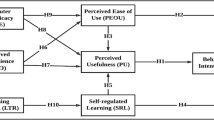Abstract
Institutions of higher education have increasing turned to web portals as a way to connect with students. These portals are designed to provide students a centralized point of access to information and services. In spite of the efforts put into developing and maintaining these portals, their use by students can be disappointing. The study described in this paper examines factors influencing the acceptance and use of academic intranet portals by university students. The research uses as its theoretical basis the technology acceptance model (TAM), one of the most widely accepted information technology utilization models from information systems literature. Two additional constructs, compatibility and enjoyment were added to the model to determine if an expanded model would better characterize user acceptance and use. A survey administered to 709 university students was analyzed using confirmatory factor analysis and structural equation modeling. The data indicated that ease of use, perceived usefulness, and attitude from the basic TAM model all contributed significantly to explaining intention and usage of the portal. In addition, the integration of enjoyment as a construct was found to improve the fit of the model. Weak measurement properties precluded the analysis of the compatibility construct. The paper includes discussion of practical and academic implications of the research.



Similar content being viewed by others
References
Adams, D. A., Nelson, R. R., & Todd, P. A. (1992). Perceived usefulness, ease of use, and usage of information technology: A replication. MIS Quarterly, 16(2), 227–247.
Ajzen, I. (1991). The theory of planned behavior. Organizational Behavior and Human Decision Processes, 50, 179–211.
Ajzen, I., & Fishbein, M. (1980). Understanding attitudes and predicting behavior. Englewood Cliffs, NJ: Prentice Hall.
Bagozzi, R. P., & Heatherton, T. F. (1994). A general approach to representing multifaceted personality constructs: Application to state self-esteem. Structural Equation Modeling, 1(1), 35–67.
Chang, S.-C., & Tung, F.-C. (2008). An empirical investigation of students’ behavioural intentions to use the online learning course websites. British Journal of Educational Technology, 39(1), 71–83.
Chen, L.-d., Gillenson, M. L., & Sherrell, D. L. (2002). Enticing online consumers: An extended technology acceptance perspective. Information & Management, 39(8), 705–719.
Cheung, E. Y. M., & Sachs, J. (2006). Test of the technology acceptance model for a web-based information system in a Hong Kong Chinese sample. Psychological Reports, 99(3), 691–703.
Chin, W. (1998). Issues and opinion on structural equation modeling. MIS Quarterly, 22(1).
Davis, F. D., Bagozzi, R. P., & Warshaw, P. R. (1989). User acceptance of computer technology: A comparison of two theoretical models. Management Science, 35(8), 982–1003.
Davis, F. D., Bagozzi, R. P., & Warshaw, P. R. (1992). Extrinsic and intrinsic motivation to use computers in the workplace. Journal of Applied Social Psychology, 22(14), 1111–1132.
Dishaw, M. T., & Strong, D. M. (1999). Extending the technology acceptance model with task-technology fit constructs. Information & Management, 36(1), 9–21.
Fornell, C., & Larcker, D. (1981). Structural equation models with unobservable variables and measurement error. Journal of Marketing Research, 18(1), 39–50.
Goodhue, D. L., & Thompson, R. L. (1995). Task-technology fit and individual performance. MIS Quarterly, 19(2), 213–236.
Hair, J. F., Black, W. C., Babin, B., Anderson, R. E., & Tatham, R. L. (2006). Multivariate data analysis (6th ed.). New Jersey: Prentice Hall.
Hendrickson, A. R., Massey, P. D., & Cronan, T. P. (1993). On the test-retest reliability of perceived usefulness and perceived ease of use scales. MIS Quarterly, 17(2), 227–230.
Jöreskog, K. G., & Sörbom, D. (2001). LISREL 8.51. Lincolnwood, IL: Scientific Software International, Inc.
Karahanna, E., Agarwal, R., & Angst, C. M. (2006). Reconceptualizing compatibility beliefs in technology acceptance research. MIS Quarterly, 30(4), 781–804.
Kendall, J. R. (2005). Implementing the web of student services. New Directions for Student Services, 2005(112), 55–68.
Klopping, I. M., & McKinney, E. (2004). Extending the technology acceptance model and the task-technology fit model to consumer e-commerce. Information Technology, Learning and Performance Journal, 22(1), 35–48.
Laudon, K., & Traver, C. (2008). E-commerce 2009 (5th ed.). Upper Saddle River, NJ: Prentice Hall.
Lee, M. K. O., Cheung, C. M. K., & Chen, Z. (2005). Acceptance of internet-based learning medium: The role of extrinsic and intrinsic motivation. Information & management, 42(8), 1085–1104.
Lewis, C. (2002). Driving factors for e-learning: An organisational perspective. Perspectives: Policy and Practice in Higher Education, 6(2), 50–54.
Lin, C., Wu, S., & Tsai, S. (2005). Integrating perceived playfulness into expectation-confirmation model for web portal context. Information & Management, 42(5), 683–693.
Mathieson, K. (1991). Predicting user intentions: Comparing the technology acceptance model with the theory of planned behavior. Information Systems Research, 2(3), 173–191.
Moon, J.-W., & Kim, Y.-G. (2001). Extending the TAM for a world-wide-web context. Information & Management, 38(4), 217–230.
Moore, G. C., & Benbasat, I. (1991). Development of an instrument to measure the perceptions of adopting an information technology innovation. Information Systems Research, 2(3), 192–222.
Ogara, S. O. (2008). Factors influencing email usage: An empirical study: Proceedings of the Decision Sciences Institute Annual Meeting, Baltimore, MD.
Pijpers, G. (2003). Guus Pijpers—research. Retrieved January 6, 2009, from http://www.guuspijpers.com/TAM.htm.
Podsakoff, P. M., MacKenzie, S. B., Lee, J.-Y., & Podsakoff, N. P. (2003). Common method biases in behavioral research: A critical review of the literature and recommended remedies. Journal of Applied Psychology, 88(5), 879–903.
Rogers, E. M. (2005). Diffusion of innovation (5th ed.). New York, NY: Free Press.
Segars, A. H., & Grover, V. (1993). Re-examining perceived ease of use and usefulness: A confirmatory factor analysis. MIS Quarterly, 17(4), 517–525.
Stair, R., & Reynolds, G. (2008). Principles of information systems. Boston, MA: Thomson Course Technology.
Stunden, A. (2002). New horizons. Educause Review, 37(3), 58.
Szajna, B. (1994). Software evaluation and choice: Predictive validation of the technology acceptance instrument. MIS Quarterly, 18(3), 319–324.
Tan, W. P., and Chan, H. C. (1998). A TAM-based assessment of videoconferencing for remote tutoring: Proceedings of Association of Information Systems Conference, Baltimore, MD.
Teo, T. S. H., Lim, V. K. G., & Lai, R. Y. C. (1999). Intrinsic and extrinsic motivation in Internet usage. Omega, 27(1), 25–37.
Venkatesh, V., Morris, M. G., Davis, G. B., & Davis, F. D. (2003). User acceptance of information technology: Toward a unified view. MIS Quarterly, 27(3), 425–478.
Whitehouse, K. (2006). Cutting through the clutter: What makes an intranet successful? Educause Quarterly, 29(1), 65–69.
Yi, M. Y., & Hwang, Y. (2003). Predicting the use of eWeb-based information systems: Self-efficacy, enjoyment, learning goal orientation, and technology acceptance model. International Journal of Human-Computer Studies, 59(4), 431–449.
Author information
Authors and Affiliations
Corresponding author
Rights and permissions
About this article
Cite this article
Presley, A., Presley, T. Factors influencing student acceptance and use of academic portals. J Comput High Educ 21, 167–182 (2009). https://doi.org/10.1007/s12528-009-9022-7
Published:
Issue Date:
DOI: https://doi.org/10.1007/s12528-009-9022-7




